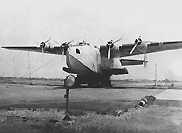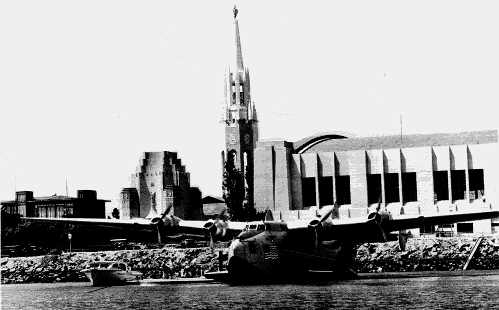
 Pan Am's Martin M-130 China Clipper inaugurates the first Pan Pacific passenger service, flying from San Francisco to the Orient. But even as it went into service, Pan Am's CEO, Jaun Trippe, was already shopping for a bigger, better aircraft.
Pan Am's Martin M-130 China Clipper inaugurates the first Pan Pacific passenger service, flying from San Francisco to the Orient. But even as it went into service, Pan Am's CEO, Jaun Trippe, was already shopping for a bigger, better aircraft.
 July 31—Pan Am gives Boeing an order for six B-314's with an option for six more. Price for each aircraft was $618,908.00
July 31—Pan Am gives Boeing an order for six B-314's with an option for six more. Price for each aircraft was $618,908.00
 January to June—Boeing delivers the first six B-314's to Pan Am. They were named, in order of construction, the Honolulu Clipper, the California Clipper, the Yankee Clipper, the Atlantic Clipper, the Dixie Clipper, and the American Clipper.
January to June—Boeing delivers the first six B-314's to Pan Am. They were named, in order of construction, the Honolulu Clipper, the California Clipper, the Yankee Clipper, the Atlantic Clipper, the Dixie Clipper, and the American Clipper.
 The second group of six aircraft, the B-314A's, are delivered, but World War II had come. As a result, three of the six were immediately sold to BOAC (British Overseas Airways Corporation) for the British war effort. They were named. the Berwick, Bangor, and the Bristol. Pan Am took possession of the remaining three—the Pacific Clipper, the Anzac Clipper, and the Capetown Clipper.
The second group of six aircraft, the B-314A's, are delivered, but World War II had come. As a result, three of the six were immediately sold to BOAC (British Overseas Airways Corporation) for the British war effort. They were named. the Berwick, Bangor, and the Bristol. Pan Am took possession of the remaining three—the Pacific Clipper, the Anzac Clipper, and the Capetown Clipper.
 The Clippers enter the War. The Pacific Clipper was purchased by the U.S. Navy. The Yankee Clipper, Dixie Clipper, and the Atlantic Clipper, were also purchased by the U.S. Navy but were operated by Pan Am. The Anzac Clipper, American Clipper, Capetown Clipper, and the California Clipper went to the U.S. Army Air Forces and designated C-98's. The Honolulu Clipper remained with Pan Am shuttling between San Francisco and Honolulu. The older Martin M-130's, the famous China Clipper and the Philippine Clipper, went to work for the U.S. Navy.  After the War, Pan Am decided not to repurchase the seaplanes. Now obsolete, they were destroyed, sold off to start-up airlines—seven to the new World Airways—or were cannibalized for parts. By the early 50's, all of the planes were gone. Thus ended the great era of the flying boats.
After the War, Pan Am decided not to repurchase the seaplanes. Now obsolete, they were destroyed, sold off to start-up airlines—seven to the new World Airways—or were cannibalized for parts. By the early 50's, all of the planes were gone. Thus ended the great era of the flying boats.
 A Pan Am 314 Clipper is shown here in the Seaplane Harbor at Treasure Island, San Francisco (about 1940). The City of San Francisco sold the manmade island to the Navy for one dollar, and it became the Treasure Island Naval Station during World War II. After the War, Treasure Island was returned to the City of San Francisco. Of the buildings shown in this picture, only the hangar remains.
Copyright © 1999-2004 Flying Clippers All Rights Reserved All materials contained in http://www.flyingclippers.com are protected by copyright and trademark laws and may not be used for any purpose whatsoever other than private, non-commercial viewing purposes. Derivative works and other unauthorized copying or use of stills, video footage, text or graphics is expressly prohibited. |
